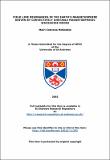Files in this item
Field line resonances in the earth's magnetosphere driven by convectively unstable magnetospheric waveguide modes
Item metadata
| dc.contributor.advisor | Wright, Andrew | |
| dc.contributor.author | McRobbie, Mairi Catriona | |
| dc.coverage.spatial | 90 p. | en_US |
| dc.date.accessioned | 2017-07-27T08:24:43Z | |
| dc.date.available | 2017-07-27T08:24:43Z | |
| dc.date.issued | 2002-07 | |
| dc.identifier.uri | https://hdl.handle.net/10023/11303 | |
| dc.description.abstract | Shear flow instabilities, such as Kelvin-Helmholtz instabilities, occurring on the Earth’s magnetospheric flanks may cause fast magnetosonic wave modes to propagate through the non-homogeneous environment of the Earth’s magnetospheric cavity. The non-uniformity in this plasma environment means the fast wave mode couples to a standing Alfvén wave mode along a closed field line in the magnetosphere with natural frequency equal to the fast wave frequency. The one-dimensional hydromagnetic box model of Southwood (1974), which treats the Earth’s magnetic field as a set of straight field lines between two ionospheric boundaries which are not perfectly reflecting, is used to model the resonance. There is a finite height-integrated Pedersen conductivity, Σp, at the boundaries of the one-dimensional box which is responsible for the damping of the field line resonance. The coupling process between the fast and Alfvén modes is represented by a simple harmonic oscillator equation driven by a time-dependent function representing the fast mode azimuthal pressure gradient, Wright (1992a,b). A fourth-order Runge-Kutta numerical integration technique is used to obtain the solution to the simple harmonic oscillation. These numerical routines are verified using analytically derived solutions for a test case of a simple driving function d{t) = Dsin(wdt). Following this test of the numerical routines, realistic driving functions from Wright et al (2002), which represent convectively unstable fast wave modes propagating through the magnetospheric cavity as a result of a Kelvin-Helmholtz instability occurring on the flanks of the magnetosphere, are used to drive the simple harmonic system. Four different unstable drivers are used, these being the fundamental and the second harmonic mode for two different values of azimuthal coordinate. For all four drivers clear resonance characteristics emerged, suggesting these may drive field line resonances in the Earth’s magnetosphere. | en_US |
| dc.language.iso | en | en_US |
| dc.publisher | University of St Andrews | en |
| dc.subject.lcc | QA927.M8 | |
| dc.subject.lcsh | Magnetosphere | en |
| dc.subject.lcsh | Wave guides | en |
| dc.title | Field line resonances in the earth's magnetosphere driven by convectively unstable magnetospheric waveguide modes | en_US |
| dc.type | Thesis | en_US |
| dc.contributor.sponsor | Particle Physics and Astronomy Research Council (PPARC) | en_US |
| dc.contributor.sponsor | University of St Andrews | en_US |
| dc.type.qualificationlevel | Doctoral | en_US |
| dc.type.qualificationname | MPhil Master of Philosophy | en_US |
| dc.publisher.institution | The University of St Andrews | en_US |
This item appears in the following Collection(s)
Items in the St Andrews Research Repository are protected by copyright, with all rights reserved, unless otherwise indicated.

